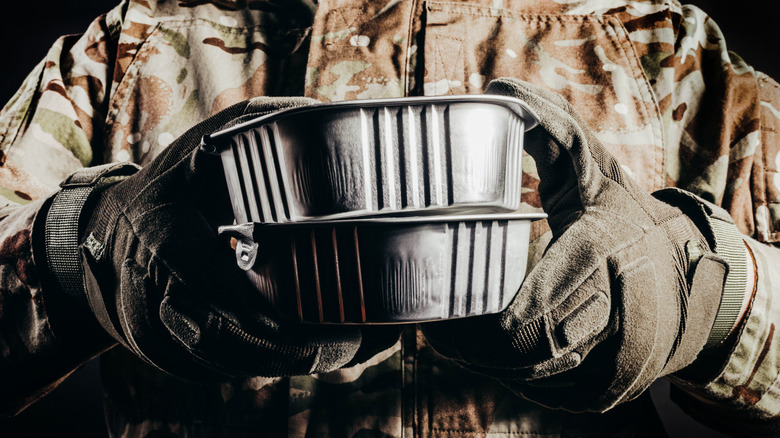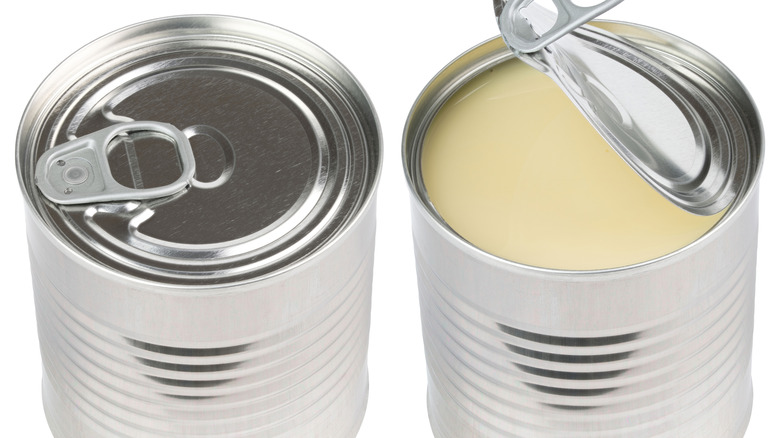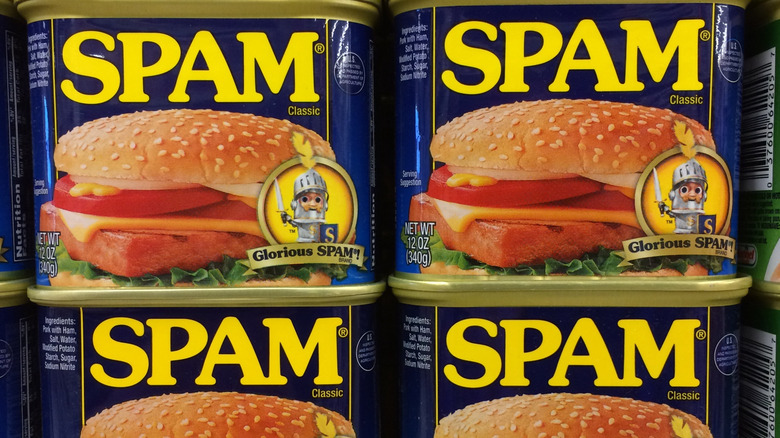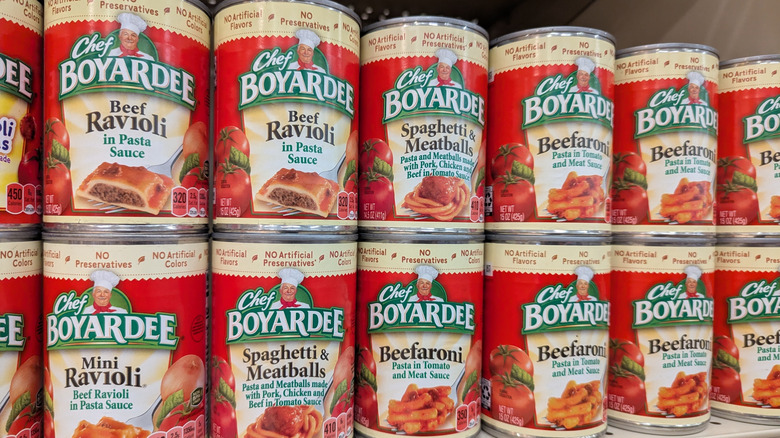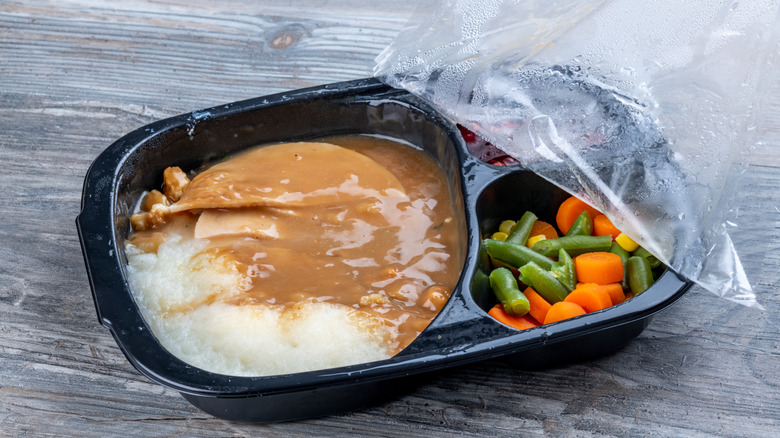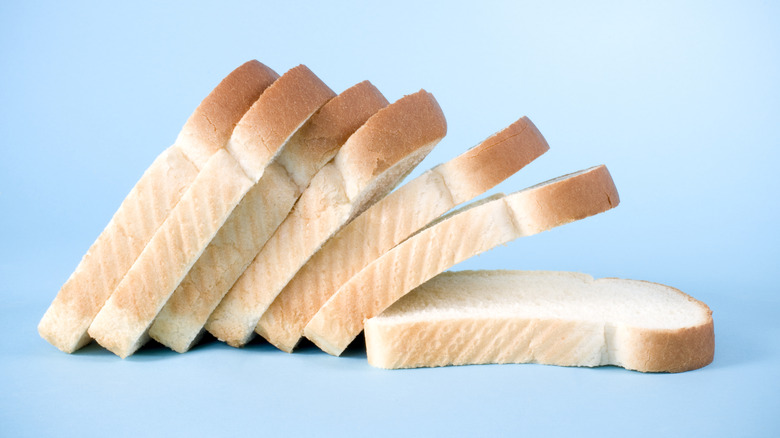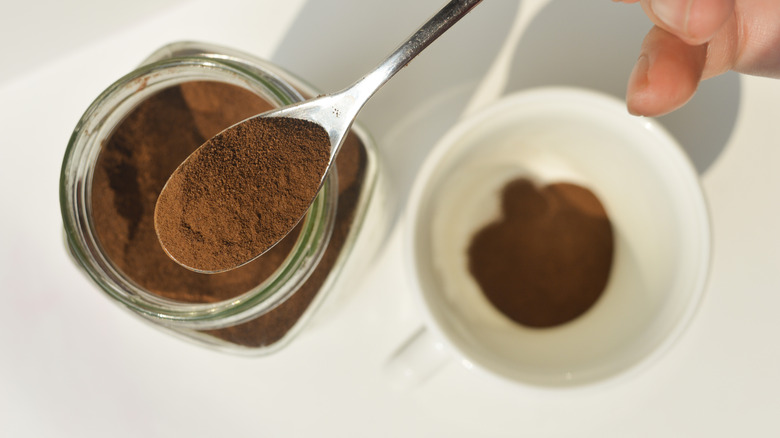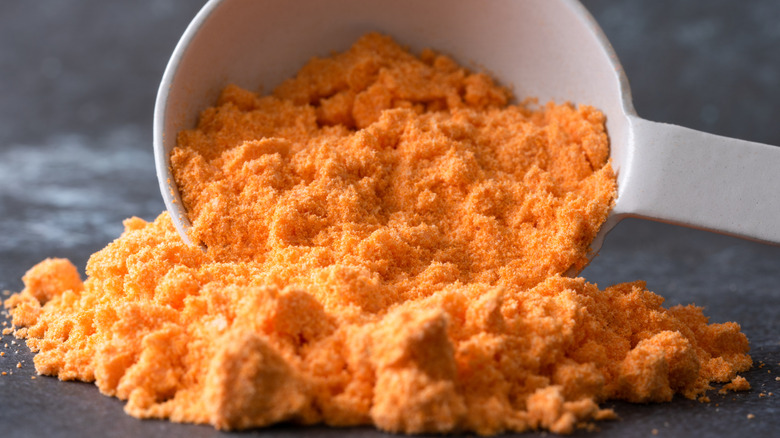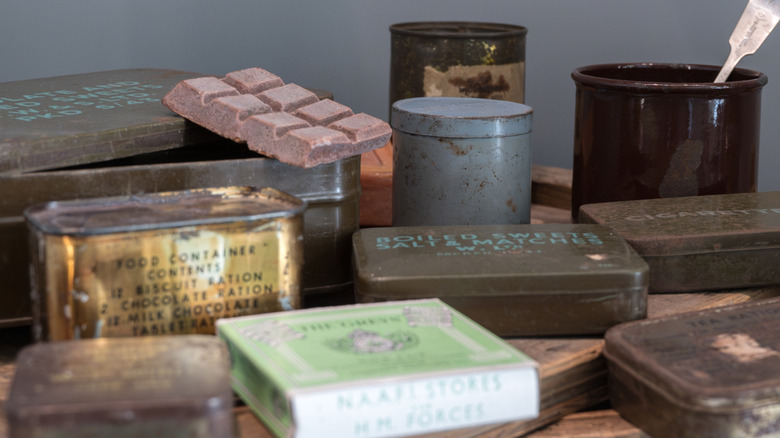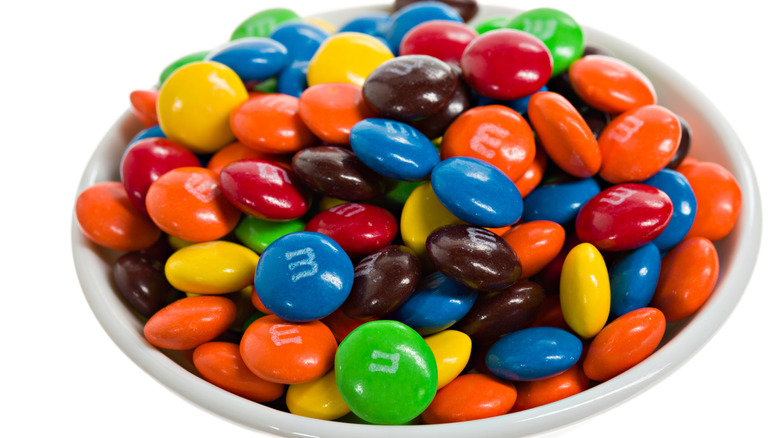Old-School Military Foods We Still Eat Today
Did you know that some of your favorite foods might have come from the military? Feeding soldiers is tough work, especially when those soldiers are in the field far from supply lines and bases. The military has always been on the cutting edge of food innovation, either inventing new foods or taking advantage of commercial advancements. But while you might think that food made for an army wouldn't be popular with civilians, it turns out that some of our best-known foods got a military start.
The same qualities that make food useful to the military — easy to transport and able to stay fresh for a long time — are also good for the grocery store. But more importantly, some of the favorite military meals were comfort foods, bringing a taste of home to the battlefield. We've gathered some old-school foods either invented by or popularized by the military that we still eat today. You'll find everything from snack foods to convenient dinners to your morning cup of George. (Keep reading to find out why it was George long before it was Joe!)
Condensed Milk
In the early 1850s, food innovator Gail Borden was experimenting with a process for creating a shelf stable milk, something that could be transported over long distances easily and remain safe to drink. Boiling milk to reduce the water content in it left the milk tasting burnt, so instead he used a vacuum pan to lower the boiling temperature of the milk, which preserved its taste and color. It took him three years to gain approval for a patent, which he received in 1856, but it took a war for condensed milk to become popular.
It wasn't until an unexpected customer walked into the company office in 1861 that Borden's fortune began to change. The customer was curious about milk that would keep indefinitely; apparently satisfied with the answers, he then ordered 500 pounds of condensed milk. The milk was intended for the U.S. Army fighting Confederate troops in the Civil War; soldiers needed food supplies that would keep in the hot conditions of the South over long periods of time.
The Army was happy with the quality of this new product and started ordering large quantities of it. And when soldiers returned home, they told their families and friends about condensed milk, which increased its popularity among the civilian population. When Borden died in 1874, the New York Condensed Milk Company was well known and condensed milk was considered a staple of American cooking. Today we use it for baked goods from quick and easy fudge to pumpkin pie.
Spam
Spam, like condensed milk, wasn't the invention of the U.S. Army. But when World War II started, the U.S. Army relied on cans of Spam to feed soldiers fighting in the war.
Spam, a shorted version of spiced ham, was first introduced by the Hormel company on July 5, 1937. Looking for food that was filling, easy to transport, and would last a long time, the U.S. military shipped over 150 millions pounds of Spam to the troops stationed in the Pacific during World War II. The canned meat was so ubiquitous that it became the butt of many jokes among the troops; "Spam is a ham that didn't pass its physical" was one of the nicer comments. America also included Spam in war-time aid packages sent to the Soviet Union and Great Britain, where civilians and soldiers appreciated the meat. As noted in a Time article, even former Soviet Premier Nikita Khrushchev said in Spam's defense, "It tasted good, nonetheless. Without Spam, we wouldn't have been able to feed our army."
Spam grew in popularity after the war, especially in places where the U.S. military was stationed, such as Hawaii and Guam. If you're cooking on a budget, Spam is a great way to stretch your pennies. And you might even find some unexpected ways to use Spam that make it one of your new favorite foods.
Chef Boyardee
The truth about Chef Boyardee is that he was not only a real person, he was also a real hero to the troops in World War II. Ettore "Hector" Boiardi came to the United States in 1914, where he quickly made a name for himself as a chef. His customers kept asking to take his pasta sauce to use at home and eventually he realized that selling ready-made pasta sauce was a winning business idea. In 1928, Boiardi and his two brothers established the Chef Boiardi Food Company and gave their product a phonetic spelling so that Americans could more easily pronounce it.
Boiardi already had connections to the military; after catering the reception at President Woodrow Wilson's wedding to Edith Bolling Galt, Wilson asked him to oversee a meal for 2,000 soldiers coming home from World War I. So when the U.S. entered World War II, the military asked him to turn Chef Boyardee products into Army rations. The Milton, Pennsylvania, production plant operated 24 hours a day to make food for both the U.S. Army and civilians at home. The Boiardi contribution to the war was so great that Boiardi was awarded the Gold Star from the War Department, the highest military honor that can be given to a civilian.
After the war ended, the Boiardi family sold the company to American Home Foods, where it eventually became part of the ConAgra Foods company. Today the familiar red label is still a favorite of hungry kids who can easily heat the canned pasta and anyone who needs some comfort Italian food.
Frozen Dinners
Frozen dinners (often called TV dinners because they're meant to be eaten in front of the television) weren't invented by the military, but the convenience made the military early adopters of frozen dinners. Starting in 1944, Maxson Food Systems Inc. used a flash-freezing technology to produce a pre-packaged meat, vegetable, and potato meal. These "Strato-Plates" were designed specifically for use on long military flights. The real innovation here wasn't just the freezing technique, but the trays and the electric ovens used to reheat the meals on the planes. It didn't take long for other companies to pick up the idea and make frozen dinners popular.
But while military research may not have been involved in creating the first frozen dinners, the Natick lab did have an impact on the packaging of frozen meals. In the 1960s, they created a material that was the best of two worlds — flexible plastic and vapor-resistant foil. This "retort pouch" is made of layered polyester, aluminum foil, and polypropylene, and today it's used to package frozen meals, juice pouches, sauce pouches, and squeeze yogurt.
McRib
Technically, the military didn't invent the McRib sandwich. But they did invent restructured meat, without which the McRib would not exist. It started with research done in the 1960s at the Army's Soldier Center for Research and Development in Natick, Massachusetts.
Established in 1949, the Natick lab has played a key role in many of the Army's food advancements. To make MREs (Meal, Ready to Eat) less expensive, they found a way to use up the discarded but still perfectly edible bits of meat from other food products and process them to form a kind of meat log. The researchers could then use the restructured meat in the MREs.
In the early 1970s, Roger Mandigo — a researcher, scientist, and Professor of Meat Science at the University of Nebraska — used the military's restructured meat process to develop a restructured pork product because he saw an opportunity. "Restructuring beef, pork, and lamb into portion controlled meat products offers a large new area for merchandising meat," Mandigo wrote in a 1974 research paper. He worked with the National Pork Producers Council to create a pork chop-shaped patty from flaked pork shoulder meat. McDonald's then asked René Arend, a chef from Luxembourg, to create a McRib recipe. Arend gave the restructured pork patty the shape, sauce, and barbecue pork taste McRib fans know and love still today.
Supermarket Bread
If something is an amazing invention, we call it the best thing since sliced bread. The military can't claim to have invented sliced bread, but it did have an impact on the most popular type of sliced bread sold in grocery stores today.
Fresh bread goes stale quickly, usually within a few days. Or if you're in hot and humid climates, it molds quickly. But the loafs of fluffy white bread you buy in the grocery store stay soft and fresh for much longer. That's because the Army Quartermaster Corps spent years developing a method to preserve bread for troops in the field.
In the 1950s, the Quartermaster Corps gave a contract to Kansas State College (now Kansas State University) to study how using a particular type of bacterial enzymes might keep bread fresh longer. The enzymes are used in the baking process, and because the tolerate baking heat, they keep working for weeks after the bread is baked. This process extends the shelf life of the bread for one to two weeks, keeping it soft and fresh that whole time. And like so many other military food innovations, the ability to have fresh bread on grocery store shelves for weeks changed the way food manufacturers and consumers make and buy bread.
Instant Coffee
Napoleon is credited with the saying that "an army marches on its stomach," but U.S. troops have also historically needed their caffeine rations, too. In the 1930s, President Andrew Jackson ordered the military to stop giving troops rum and brandy rations and instead switch them to coffee. But carrying enough coffee beans, sugar, and milk (and the equipment to roast and grind the beans) to satisfy an army wasn't easy.
When the Civil War started, the U.S. military turned to instant coffee. H. A. Tilden & Co. created a dehydrated blend of coffee, sugar, and milk. This powdered mix was named George Hummel's Premium Essence of Coffee and the troops compared it to axle grease. It didn't last past the end of the Civil War, but the need for instant coffee to feed troops didn't go away.
In 1910, Belgian immigrant George Constant Washington built the first mass production plant for instant coffee in Brooklyn, New York. America's military began purchasing the product when they entered World War I in 1917. By the end of the war, the U.S. was asking for 37,000 pounds of instant coffee per day. Even with the worst instant coffee, military troops still appreciated having something hot and familiar to drink — in fact, instant coffee was known by soldiers as "cup of George" (after George Constant Washington) before it was called a "cup of joe." After the war, competitors improved on the dehydration process and instant coffee became just as much of a home staple as a must-have on the front lines.
Powdered Cheese
You might notice a theme of dehydrating foods for military use — that's because those foods are lighter, last longer, and are easier to transport. Those same qualities also transfer to civilian favorites in ways you might not expect, like with cheese powder.
The U.S. military worked for years to find better ways to make cheese that would last longer in the field. Processed cheese was the first innovation, with the Army buying twenty‑five million quarter‑pound tins produced by cheese-giant Kraft during World War I. By the time World War II started, they were looking for different ways to process that cheese. In 1943, U.S. Department of Agriculture dairy scientist George Sanders created the first cheese powder and the military jumped on the opportunity to use it.
At the end of the war, though, there was a surplus of cheese powder sitting in military warehouses, so they sold some of it back to food manufacturers at a discount. Which is where we get the connection between snack foods like Cheetos and the military. Frito company founder Charles Elmer Doolin was also a military supplier. In 1948, he bought some of the surplus cheese powder and used it to create a new snack food: a corn puff coated in cheese dust called Cheetos. The same military-created cheese powder also became the foundation for the famous blue box of Kraft Mac & Cheese.
Energy Bar
The first energy bar was designed by the military to be nutritious but not too tasty. In 1935, the U.S. Army Quartermaster General's office worked with the Hershey Company to create a chocolate bar that was light and easy to carry, didn't melt, and was an outstanding energy source. But because these were meant to be eaten only as a last resort, they also had to be something troops wouldn't want to eat unless they absolutely had to.
The Ration D bar succeeded at not being too edible. It was dense and bitter, and the recommendation was to nibble on it slowly or let it dissolve in water and drink it. In 1943, Hershey created the Tropical Chocolate Bar, which had a slightly better taste but was still nutritious and easy to transport. The Ration D bar wasn't produced after the end of World War II, but the Tropical Chocolate Bar was given to soldiers through 1991.
But the Army kept working on making a better energy bar. In the mid-1960s, inspired by new techniques to create intermediate moisture food (shelf stable food with a water content of 10-50%, which allows it to stay soft but not spoil), the Natick Soldier Systems Center created a sweet, fortified apricot bar. And in 1996, the Natick lab created the HooAH! bar, a performance nutrition bar for Army soldiers. Today, you can buy energy bars of any flavor in every grocery store, all thanks to the military.
M&Ms
M&Ms are regularly ranked as one of the most popular candies in the United States, but when they were introduced in the 1940s, this candy wasn't sold to the public. They were produced specifically for the U.S. military in World War II and didn't become available to everyone else until 1947.
It's possible that the inspiration for M&Ms came from the Spanish Civil War. American businessman Forrest Mars, Sr. was in Spain during the conflict; the story goes that he saw soldiers eating candy-covered chocolate that didn't melt even in the heat. If you're familiar with European candy, you might notice some similarities between M&Ms and Smarties — that's because there's a version of this story where Mars was traveling with George Harris, another confectionary producer. The two men realized the potential of the hard shell-covered chocolate and made a handshake agreement that Mars would make the candy in the U.S. and Harris would make it in Europe.
This story may just be an urban legend, but however it happened, Mars took the idea back to the U.S. and formed a partnership with Bruce Murrie from Hershey Chocolate, naming the candy after their combined initials. Mars and Murrie sold M&Ms to the U.S. military as a treat for soldiers that wouldn't melt in hot climates. They packaged the candies in cardboard tubes to make distribution easy. M&Ms were a big hit with the troops, and when the soldiers came home, they brought their love of M&Ms with them.
